These 5 Statistics Are The Secret To Keeping Your Funeral Home Alive
August 3rd, 2016
The funeral profession has changed a lot in the last 10-20 years… statistics show it, and funeral professionals have experienced it first-hand.
Families now learn about funeral services on the internet rather than inside a funeral home, the way funeral homes need to market their value has changed in virtually every way, and this year (for the first time ever) cremation rates are predicted to surpass burial rates in the United States for the very first time.
But these changes aren’t the only ones that are taking place in the funeral profession. There are a whole host of eye-raising, industry-changing statistics popping up that have the power to completely revolutionize the profession we know and love.
And no, we’re not talking about the Baby Boomer bubble that is going to send death rates soaring and throw the funeral profession into overdrive. (Although that certainly is a coming change on the horizon.)
We’re talking about statistics that show right now ﹘ not in the “deal with it later” distant future ﹘ the families that we work with day in and day out are wanting something completely different than what the average funeral director is providing them.
If we don’t embrace the following statistics and make the changes that families want, we might as well be burying ourselves next.
1. What families value in a funeral has completely changed
There is no doubt that funeral directors constantly try to deliver the most impactful, important funeral service possible to the families that they serve. But each year, the gap seems to grow bigger between what funeral directors think is an important part of a funeral service, and what their families do.
For example, when we asked our funeral audience what they thought was the single most important part of a funeral service last year, many said it was making the deceased look great for the family.
“The most important part [of a service] is the way the deceased looks in the casket. [Families] need to be able to look in there and see their loved one the way they remember them.” – Rick M., Funeral Director
But according to a recent NFDA research study, the importance of having a body present at a funeral service has declined significantly year after year.
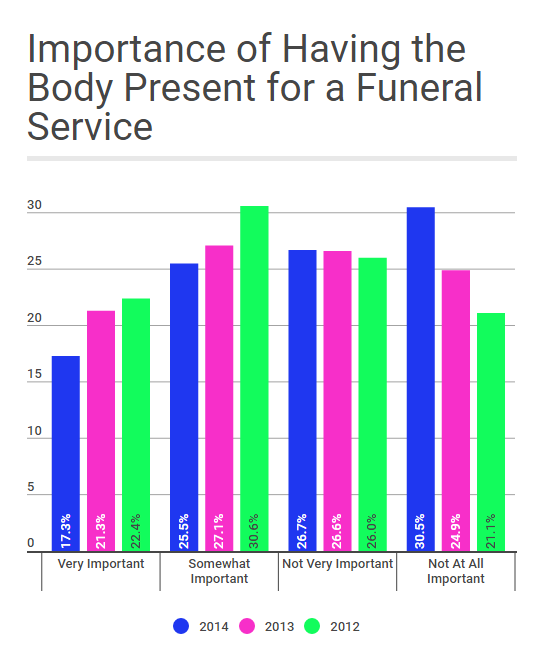
The importance of having a religious component included in the funeral of a loved one has also become less important to families each year, with only 44.3% of 2014 respondents saying that a religious funeral element was very important to them (down from 49.5% in 2012), while the number of respondents that said a religious component was not at all important (14.3%) has risen steadily from just 10.4% in 2012.
This is also reflected in the type of officiant that many families are now choosing for their loved one’s funeral service, as more and more people are considering using a celebrant over a religious officiant every year. (See below.)
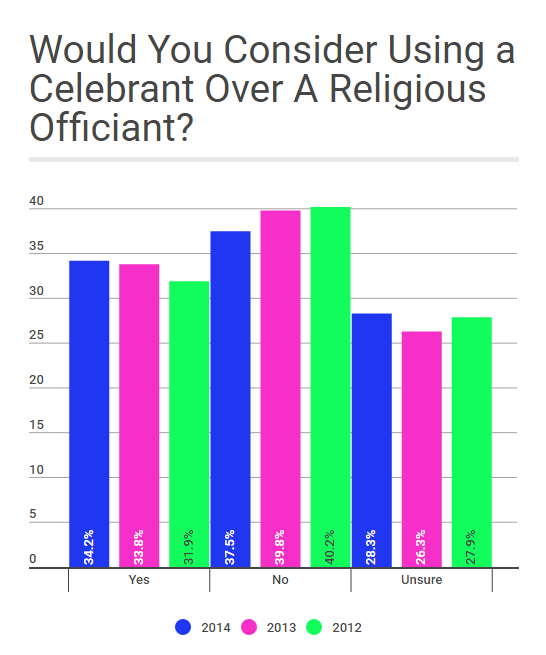
2. Families are starting to question the necessity of funerals
As funeral professionals, we understand what an important and valued tradition a funeral service can be. However, not all families have been educated on the benefits of having a visitation, a burial or even a funeral. In fact, when we began doing research into how families felt about the funeral process, we were shocked to come across some of the following quotes:
“Traditional funerals are mindless. You just go through the motions. You think, is that all this person was worth?”
“I feel like we’re forced to feel sorry instead of being able to celebrate.”
“A preacher talked for a bit, spewing platitudes and crap. That part was certainly a waste of time.”
“I’m sad they didn’t put any energy into their ‘celebration of life.’ We just have to bury the old broad and get on with our life.”
Just to be sure that our eyes weren’t deceiving us, we decided to find out for ourselves what people think of funerals… and we were shocked to find out that only 51.9% of respondents felt that funerals were an important tradition in life. The rest? Well, see for yourself…
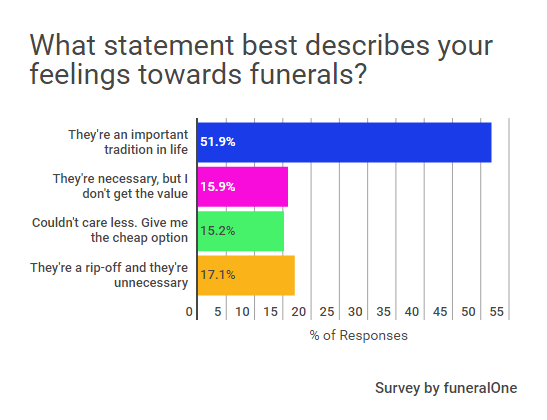
That means that nearly half of the families you serve don’t understand the value of what they’re paying you for… and 17% of those families think your services are “unnecessary” and a “rip-off.” That’s bad news for the many funeral professionals out there that count on the “necessary tradition” of funerals to keep their business afloat, because according to today’s families, your services become less and less necessary every day.
To read our full blog post on what families really think about funerals, click here.
3. Families want a party or celebration… not a boring ol’ funeral.
The term “Pinterest-worthy” has taken hold of nearly every special occasion in our lives… Kids birthday party? Better be Pinterest-worthy. Your wedding day? Gotta create an entire board around the Pinterest-worthy aesthetic that you want.
But this desire to have better events and parties doesn’t just stop there… Even funerals are beginning to pop-up in the Pinterest world, as people begin dreaming of ways to make their own funeral feel more personalized. In fact, 30% of people say that they want a party over a traditional wake, and nearly half of all funeral directors (49%) have arranged a funeral outside of a religious setting. Even funeral trends are starting to have more of a party vibe to them ﹘ service add-ons like a food or beverage station are becoming one of the fastest growing funeral trends in the last few years.
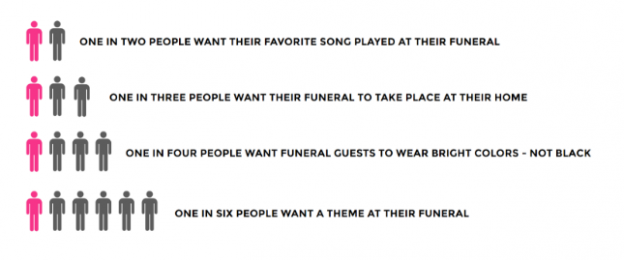
So what do all of these statistics tell us? Funerals are moving away from a dark, somber tradition and are transforming into a unique, exciting way to celebrate life. Families have already started to change their expectations about what they want from their local funeral home, and now they’re just waiting for the profession to catch up.
4. People are attending less and less funerals every year.
In NFDA’s latest Consumer Awareness and Preferences Study, it was unveiled that the number of funerals that people had attended in the last 5 years was slowly beginning to drop. The amount of people that attended 6 or more funerals in 2014 had dropped to 20.2% (it was 25.5% in 2012), and the number of people who attended between 3-5 funerals had followed suit (34.7% of people in 2014, down from 35% in 2012.) Meanwhile, the number of people who had not attended a funeral in the last 5 years rose to 15.1%, up from 11.6% in 2012.
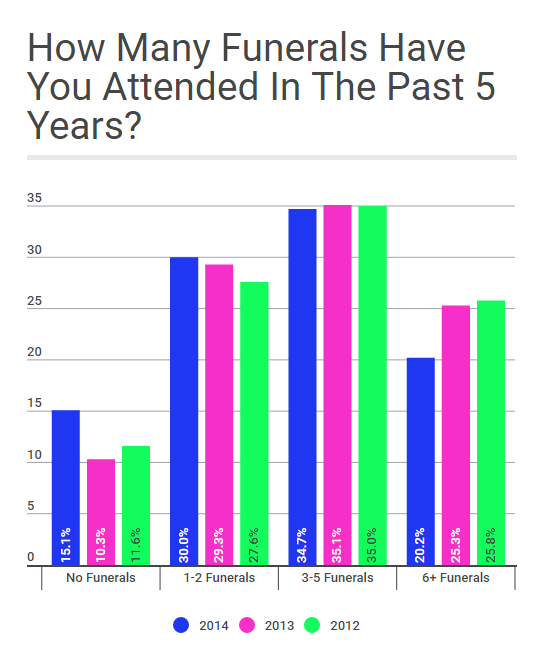
According to Bill McQueen, former president of Anderson-McQueen Family Tribute Centers, the demographics of the people involved in this survey were particularly “troubling” to him, because they are often considered the “sweet spot” when it comes to funeral attendance.
One reasoning behind this trend may be the desire by families to offer condolences online, rather than in person. Thankfully many funeral professionals are already embracing this change, and are offering online outlets of support to their families ﹘ like funeral webcasting or online memorial websites ﹘ so that they can still provide their value to friends and families, even when they are not there in-person at their funeral home.
To learn more about how you can incorporate these important online solutions into your funeral home so you continue to support your families in every situation, click here to talk to one of our funeral success specialists.
5. Funeral Success doesn’t live and die with Baby Boomers
We’ve all heard about the magic generation that is going to swoop in and save the health of funeral homes once and for all ﹘ the Baby Boomers. But what about the large generations that will follow in the footsteps of these Boomers? For instance, Millennials have actually overtaken our precious Boomers as the largest generation to date, which means that the death rate will only continue to rise from here on out.
Today, there are about 2.6 million deaths every year, and this number will rise to over 4 million a year by 2050… and the Baby Boomers will just be the beginning of this.
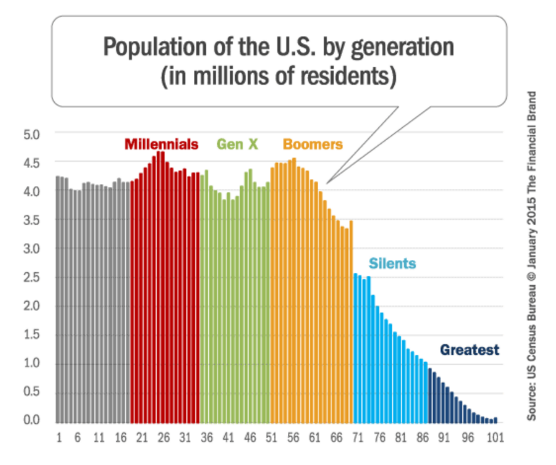
But don’t go getting too excited about the increase in business just yet. What many funeral directors don’t realize is that the large increase in death rates isn’t going to be the magic solution that saves their funeral business. In fact, it could do just the very opposite.
If you don’t embrace the changing needs of families that we mention above, you will have a front row seat as you watch families and friends of these large generations flock to whichever of your competitors was quick to adapt to their needs early on. The real “winner” in our profession will be the newcomer to the profession who rejected the “old-school” mindset, and approached our profession with a savvy business mindset ﹘ rather than treating it like a family heirloom.
If you want your funeral home to survive, you need to do the same. Embrace changing technology and marketing needs, use your funeral website as the invaluable educational resource that it is, evolve the traditional funeral practices you’ve used for years, and go all-in on personalized celebrations of life.
If you’re ready to make that transition once and for all, we’d love to help. Click here to talk to one of our funeral success coaches today.




As a Certified Celebrant, I fund myself doing more and more celebrations/memorials each month. I have worked with our directors emphasizing the value of a service – to the survivors, and friends who do wish to pay homage and respect. I have also dropped the word “funeral” from my presentation to families at the family conference I always have. The word “funeral” is dark and leaves the impression of the cookie cutter events we have all been to in the past. I tailor each service to the individual we are honoring. I work with our directors to explain the honorarium that is expected – to their client families. As an independent contractor for providing these services, I spend hours in preparation, well before the presentation. I also create a takeaway item(s) for presentation to the families as a remembrance of the event. The business is indeed changing. Cremations outnumber burials now in most localities, but this does not in any way circumvent the value of a celebration of life (not a funeral). The business must continue to evolve, because the clients have choices.
Allan, thanks so much for the thoughtful comment. It sounds like you are providing a much-needed, invaluable service to your families. Thanks for doing what you do 🙂
Rochelle:
This is an excellent post and certainly should be a wake up call for many in our profession, however most are unlikely to do the work necessary to address the obvious consumer trends. Unfortunately, although the data is good, it’s old (2014)…in essence the numbers a year and a half later are certainly higher negatives. But, as the mantra goes for most “we’ve always done it this way” and their outdated business model will continue to decline. Good work! #thefuneralcommander
I WORKED IN THE FUNERAL BUSINESS FULL TIME FOR ABOUT 10 YEARS AND I UNDERSTAND WHY PEOPLE THINK FUNERALS ARE A RIP-OFF BECAUSE I KNOW WAHAT THE FUNERAL HOMES PAY FOR THOSE CASKETS AND VAULTS AND WHAT A HUGE MARK UP IT IS IN A CASKET AND VAULT. THOSE MARK UPS CAN RANGE FROM A 110 PRE CENT AND UP. IF PEOPLE REALLY KNEW WHAT A 10,000.00 DOLLAR FUNERAL COST THE FUNERAL HOME THEY WOULD BE OUT RAGED AT THE PROFIT THE FUNERAL HOME WAS MAKING. MOST FUNERAL DIRECTORES LIVE IN FINE HOME DRIVE FANCY NEW CARS AND SUV”S AND LIVE A VERY HIGH LIFE STYLE.
The cost of a funeral is also affected by how much the state collects on sales tax and what the family desires on cash advance items.
There are times when we might have a funeral that costs 2500-5000 without burial or a lot of merchandise.but people don’t realize what goes into that price break down.
There is cost of delivering the body to the facility, refrigeration, if a family wants to have a final viewing then the body needs to be prepared for the viewing. The preservation of the body until the family decides what they want to do. Cost of filing with the state and county for permits, Insurances and taxes on the the overhead of the facilities. Salaries need to be paid to the administration and operations staff. If there is a cremation, the cost of the natural gas to fire up the chamber. Then there is the cost of disposition… if the person is being cremated, are they being scattered at sea? returned to the family residence? or interred in a niche or buried?
I love how people immediately feel funeral homes are a rip off without analyzing the true cost of providing the services that no one really knows how much time , effort and energy goes into helping a family deal with a loss of a loved one. Yes, there might be a mark up on merchandise.. but what business do you know of.. (auto, clothing, food, electronics.. etc) isn’t there a markup on the merchandise.
Live the life of a funeral director for one week and you will quickly realize it is not as glamorous as most people think.
What you have said is one of the reasons cremations have gone up.Most people are not in a position to pay the high coast of a ttraditional funeral.
[…] recent decades, funeral home services have changed significantly. While seeing the deceased and upholding centuries-old traditions was important in the past, many […]